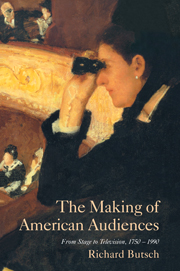Book contents
- Frontmatter
- Contents
- Acknowledgments
- Introduction: Participative Public, Passive Private?
- 1 Colonial Theater, Privileged Audiences
- 2 Drama in Early Republic Audiences
- 3 The B'Hoys in Jacksonian Theaters
- 4 Knowledge and the Decline of Audience Sovereignty
- 5 Matinee Ladies: Re-gendering Theater Audiences
- 6 Blackface, Whiteface
- 7 Variety, Liquor, and Lust
- 8 Vaudeville, Incorporated
- 9 “Legitimate” and “Illegitimate” Theater around the Turn of the Century
- 10 The Celluloid Stage: Nickelodeon Audiences
- 11 Storefronts to Theaters: Seeking the Middle Class
- 12 Voices from the Ether: Early Radio Listening
- 13 Radio Cabinets and Network Chains
- 14 Rural Radio: “We Are Seldom Lonely Anymore”
- 15 Fears and Dreams: Public Discourses about Radio
- 16 The Electronic Cyclops: Fifties Television
- 17 A TV in Every Home: Television “Effects”
- 18 Home Video: Viewer Autonomy?
- 19 Conclusion: From Effects to Resistance and Beyond
- Appendix: Availability, Affordability, Admission Price
- Notes
- Selected Bibliography
- Index
- Plate section
12 - Voices from the Ether: Early Radio Listening
Published online by Cambridge University Press: 05 June 2012
- Frontmatter
- Contents
- Acknowledgments
- Introduction: Participative Public, Passive Private?
- 1 Colonial Theater, Privileged Audiences
- 2 Drama in Early Republic Audiences
- 3 The B'Hoys in Jacksonian Theaters
- 4 Knowledge and the Decline of Audience Sovereignty
- 5 Matinee Ladies: Re-gendering Theater Audiences
- 6 Blackface, Whiteface
- 7 Variety, Liquor, and Lust
- 8 Vaudeville, Incorporated
- 9 “Legitimate” and “Illegitimate” Theater around the Turn of the Century
- 10 The Celluloid Stage: Nickelodeon Audiences
- 11 Storefronts to Theaters: Seeking the Middle Class
- 12 Voices from the Ether: Early Radio Listening
- 13 Radio Cabinets and Network Chains
- 14 Rural Radio: “We Are Seldom Lonely Anymore”
- 15 Fears and Dreams: Public Discourses about Radio
- 16 The Electronic Cyclops: Fifties Television
- 17 A TV in Every Home: Television “Effects”
- 18 Home Video: Viewer Autonomy?
- 19 Conclusion: From Effects to Resistance and Beyond
- Appendix: Availability, Affordability, Admission Price
- Notes
- Selected Bibliography
- Index
- Plate section
Summary
Only two decades after movies created a historic juncture from live to recorded entertainment, radio instituted another great transformation, bringing into the home entertainment previously available only in public theaters. Broadcasting changed the collective dimension of public audiences, dispersing them to their homes. The phonograph had this potential, but it spread very slowly. For decades it was expensive and severely limited as a music instrument. The phonograph was quickly overshadowed by the much less expensive, more versatile, and fascinating technology of radio.
Radio broadcasting was born in the 1920s, a decade that, in many ways, divided the nineteenth century from the twentieth. Technologies such as the automobile, telephone, and household electrification took hold. Changes in sexual mores, gender roles, and child-rearing practices that had been brewing for some time gelled into “modern” middle-class culture. Reactions to radio can be appreciated within this context.
Radio's first incarnation, however, was not as entertainment broadcasting, and radio listening was not the first leisure use of radio. Radio began as a wireless telegraph, transmitting dots and dashes through the air. The signals were broadcast, rather than transmitted point to point, but the purpose was two-way communication, as with wire telegraphy. In the early 1900s a hobby of amateur wireless operators sprang up, mostly middle-class schoolboys. Local clubs and a larger informal network of amateurs quickly evolved into a national organization, the American Radio Relay League, to promote communication among amateurs.
- Type
- Chapter
- Information
- The Making of American AudiencesFrom Stage to Television, 1750–1990, pp. 173 - 192Publisher: Cambridge University PressPrint publication year: 2000



